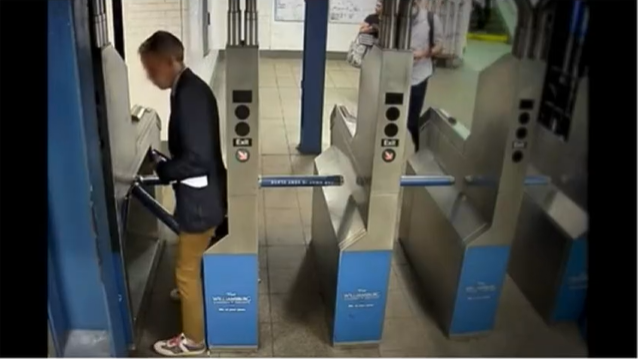Could MTA's fight against fare beating force passengers to prove they paid?
May 22, 2024, 4:30 p.m.
MTA Chair Janno Lieber did not rule out implementing a system that would require passengers to show proof of payment before exiting a subway station.

After years of calling fare evasion an “existential threat” to public transit, MTA Chair Janno Lieber signaled Wednesday he’s running out of patience with the problem – and threatened to fundamentally change the way New Yorkers use the subway system.
Speaking at an MTA board meeting, Lieber said he was considering the “maximal option” of requiring commuters to show proof they paid the fare before leaving a station, as is done in subway systems around the world.
“We have to win or else the system's gone,” Lieber warned.
Lieber stopped short of saying he would implement such a measure. He detailed more immediate efforts to crack down on fare beaters, including hiring 471 private security guards to stand near exit gates at 50 stations, increasing enforcement, and the installation of a few new turnstiles.
Those initiatives are building on ongoing efforts that have so far failed to turn the tide on fare evasion.
Lieber expects the MTA to lose as much as $800 million this year from fare evasion on subways and buses – about the same amount the agency lost in 2022.
Lieber said he’ll focus on those efforts before forcing riders to show proof of payment.
“We're going to try a lot of other stuff first,” he said.
The “other stuff” also includes expanding the 15-second delay on exit gates before they can be opened, which is in effect at just three stations. For Lieber, preventing people from streaming through an open exit gate is his white whale.
“When you open that gate, 20 people walk in,” said Lieber, seemingly particularly exasperated. “It’s 20 people walking in with MetroCards in their hands. So that's why we're going to fight the fight on the [delayed] gate. That's why the delay matters so goddamn much.”
Other recent technical fixes include adjusting 1,400 turnstiles at 105 stations to make them harder to back-cock — as a popular form of casually hopping the turnstiles is known. The MTA hopes 60% of stations will be modified to prevent back-cocking by the end of the year.
The NYPD has surged thousands of police into the system this year, which has led to an increase in ticketing, with over 100,000 summonses issued last year for fare evasion.
The tickets increased to $100 this year. But the MTA reports more than half the people ticketed don’t even pay the fine.
Once the MTA hires the additional unarmed private security guards to stand next to the exit gates, more than 1,000 total will be stationed throughout the system at a cost of $1 million a year.
The agency is also installing new turnstiles it calls “wide aisle gates.” The turnstiles with paddle doors were famously evaded last year by a dancing TikTok star who casually strolled through without paying by waving his hand over a sensor. The MTA confirmed that flaw has been fixed. It plans to install similar turnstiles with taller gates at 15 stations this year.
Some board members question the ongoing obsession with subway fare evasion when only 13% of riders don’t pay. Some members argued that the MTA should focus on buses, where fare evasion is a much more significant problem. More than half of Select Bus Service riders don’t pay, while 47% of riders on local buses skip the fare, according to the most recent MTA stats covering the first three months of 2024.
The MTA didn’t announce new measures for buses. Six months ago, the MTA dispatched additional “Eagle Teams” onto buses to enforce laws against fare beating.
“If the main drain on MTA resources is in the buses, not only in terms of the rate of fare evasion, but the amount of money lost to the MTA… you should be focusing on where we're losing the money,” MTA board member David Jones told Gothamist.
Lieber called bus fare evasion “a completely different situation.”
“There's no reason to engage in comparison,” he said.
The NYPD issued more than 100K fare evasion tickets last year. See how many were at your stop.